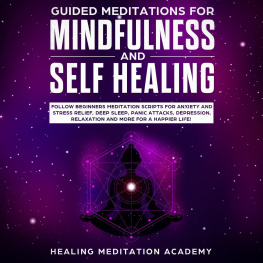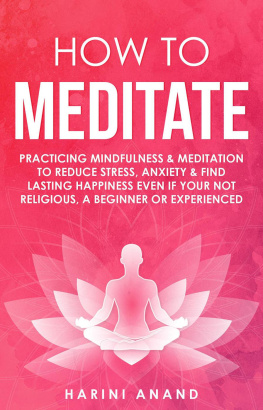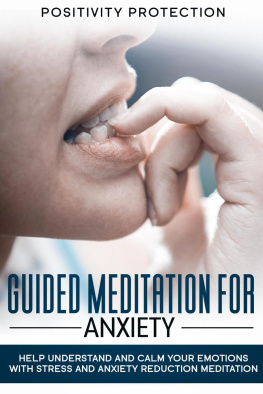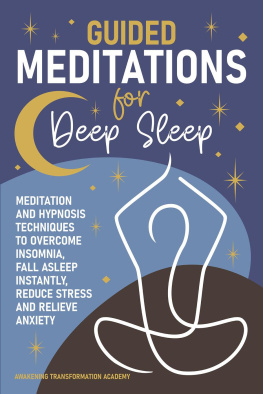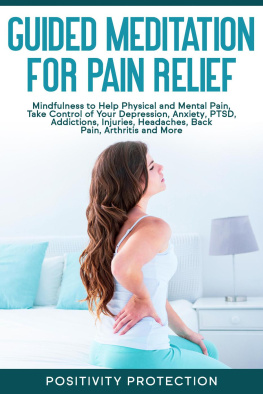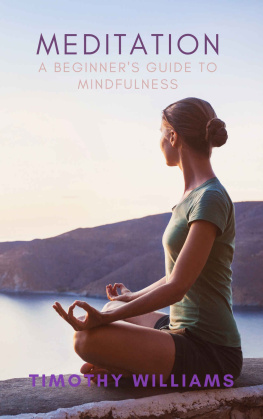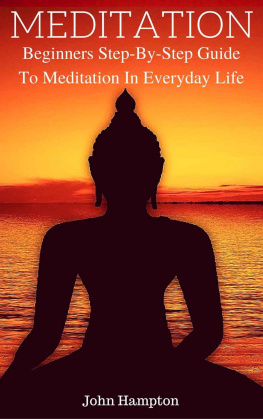Guided Meditations for Mindfulness and Self Healing
Follow Beginners Meditation Scripts for Anxiety and Stress Relief, Deep Sleep, Panic Attacks, Depression, Relaxation and More for a Happier Life!
While every precaution has been taken in the preparation of this book, the publisher assumes no responsibility for errors or omissions, or for damages resulting from the use of the information contained herein.
GUIDED MEDITATIONS FOR MINDFULNESS AND SELF HEALING: FOLLOW BEGINNERS MEDITATION SCRIPTS FOR ANXIETY AND STRESS RELIEF, DEEP SLEEP, PANIC ATTACKS, DEPRESSION, RELAXATION AND MORE FOR A HAPPIER LIFE!
First edition. May 27, 2019.
Copyright 2019 Healing Meditation Academy.
ISBN: 978-1393226321
Written by Healing Meditation Academy.
10 9 8 7 6 5 4 3 2 1
By Healing Meditation Academy
Table of Contents
Guided Meditations for Mindfulness and Self Healing
Chapter 1: Mindfulness Meditation
Beginner Breathing (10 minutes if done individually)
The Stimulating Breath: The aim here is to enhance your overall alertness and internal energy sources.
The 4-7-8 Exercise
Breathing Exercise Three:
Breathe Counting
Anger Relaxation
Grief Relaxation
Chapter 2: Chakra Healing Meditation
Root Chakra Meditation (Meditation time approx. 15 when repeated 2 times)
Root (2)
Sacral Chakra Meditation (Meditation time approx. 15 when repeated 2 times)
Sacral Chakra (2)
Solar Plexus Meditation (Meditation time approx. 15 when repeated 3 times)
Solar Plexus (2)
Heart Chakra Meditation (Meditation time approx. 15 when repeated 2 times)
Heart (2)
Throat Chakra Meditation (Meditation time approx. 15 when repeated 3 times)
Throat (2)
Third Eye Chakra Meditation (Meditation time approx. 15 when repeated 2 times)
Third eye (2)
Crown Chakra Meditation (Meditation time approx. 10 when repeated 3 times)
Body Scan (10 mins. Repeat 5x)
Chapter 1: Mindfulness Meditation
B eginner Breathing (10 minutes if done individually)
The Stimulating Breath: The aim here is to enhance your overall alertness and internal energy sources.
- Begin by first inhaling and then exhaling in a rapid manner through your nostrils. Remember to keep your mouth completely closed but still very relaxed. Ensure that your breathing is exactly equal in its duration while making sure that the breaths are short. You will find that this particular exercise is rather loud.
- Aim for around 3 inhales and exhales each second. This will create a very sharp movement of your diaphragm similar to a bellows. After each individual breathing cycle, you can start to breathe normally for a short period of around 1 minute.
- On your very first attempt, refrain from doing this for more than 20 seconds. You can, however, increase your time by the duration of 5 seconds until a full minute has been reached. After a while of performing this exercise, you will likely feel boosts of energy and awareness similar to a great workout.
The 4-7-8 Exercise
Begin by sitting with your back completely straight. Then, place this tip of the tongue along with the tissue that sits right behind the upper portion of your front teeth hold it here for the duration of the exercise. This exercise will require that you exhale through your mouth and around the tongue. If the movement is too awkward, you can also purse your lips for added comfort.
- Exhale all the way through your mouth, creating a whooshing noise.
- Next, inhale silently after closing your mouth. Inhale through your nose for a total duration of 4 seconds.
- Ensure that your breath is held for a period of 7 seconds.
- Now, begin to exhale with a whooshing noise through your mouth for 8 seconds.
- This counts as one cycle of breathing. Now, you are to inhale once again and restart the original cycle. Do this 3 times totaling 4 breaths.
Keeping mind that this breathing excursive requires that you continually inhale through the nose and exhale through the mouth. Make sure that your tongue is kept in the same position at all times during the exercise. Also, you will notice that exhaling will last nearly twice the amount of time as inhaling will. However, the total amount of time that is spent during each breathing sessions is not of integral importance just as long as you remember the 4:7:8 ratios.
Breathing Exercise Three:
Breathe Counting
Perform this meditative exercise for 10-15 minutes per session. This time is preferred because it allows you to fully garner all of the best benefits that mindfulness meditation has to offer. However, if you are pressed for time, you will find that even a few minutes will carry many benefits for you as well.
- Sit in a comfortable position with your back completely straight and your head leaning forward.
- Start to shut your eyes and inhale slowly and deeply.
- Next, exhale slowly without being too forceful. You want this rhythm to be slow and quiet, but it is okay if these vary for you.
- Acknowledge incoming thoughts even if they are plentiful. Let go of them and return to your breath as soon as you recognize that you have become distracted.
- Start conducting a full scan of your body from the top of your head down to your feet.
- Notice any subtle or strong sensations in all of the areas that you scan.
- As you move along your body and begin to notice sensations, recognize them and let go. The goal is only to heighten awareness of these sensations, rather than trying to change them.
- Now, count one when you exhale. Remember to release your breath very slowly and at a measured pace.
- Next, count two... continues sequentially to a count of five totals.
- Once you have reached a count of five, restart the cycle by counting one for the next exhale.
- Be sure to refrain from counting any higher than 5 once you exhale. If your count reaches beyond 5, this is a clear indication of your attention having wondered.
In this next module for mindfulness meditation, we will tackle pain management. I will guide you along with a session designed to have you concentrate on acceptance and observation. In this way, you will be able to morph all of your pain, and then focus your mind during the meditation exercise to install both mental and physical calm and relief from pain.
- So, start by finding and settling into a comfortable position ensuring that your back has enough support. While you are laying on your back, or if you are seated in a chair with enough support for your head, you can begin this session.
- As you come to settle yourself, take notice of how your body and mind feel in this unique moment. Remember, you do not need to attempt to change anything at this moment. Simply become a patient, calm and distant observer of your physical and mental state. Managing pain starts with simple and calm observation.
- Now, notice where some of your pain and tension is being carried. Where is the pain in your body? Which parts of your body are calm and at ease?
- Start conducting a full scan of your body from the top of your head down to your feet.
- Notice any subtle or strong sensations in all of the areas that you scan.
Next page
